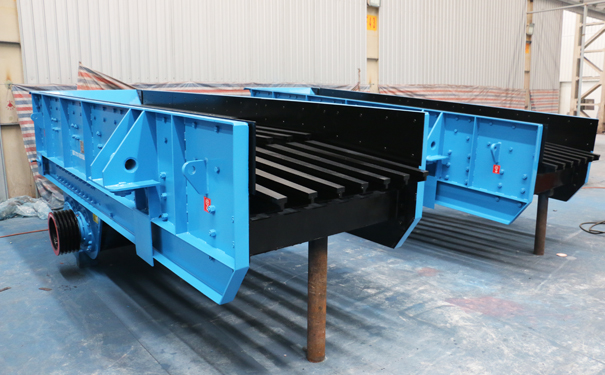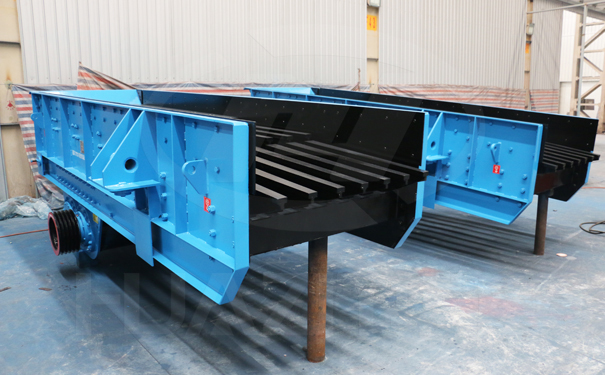Vibrating feeder is a kind of commonly used feeding equipment. In production, it can uniformly and continuously send block or granular materials to the receiving equipment, which effectively improves the degree of automation of production, improves production efficiency, and greatly reduce the labor force of workers. In the production process, the vibrating feeder will also have some common failures, which affect the normal feeding operation, thereby affecting the production operation of the entire production line. Let’s take a look at several common faults and solutions of the vibrating feeder:

1.No vibration or intermittent operation after the equipment is started
Cause of issue:
1) The fuse of the vibration motor is blown or the coil is short-circuited;
2) The protective cover is damaged and rubs against the eccentric block.
Solution:
1) Replace the new fuse in time, check the coil layer or turn of the vibration motor, eliminate the short circuit phenomenon, and connect the lead wire;
2) Repair or replace the protective cover, and adjust the angle of the eccentric block.
2. No feeding or insufficient feeding amount
Cause of issue:
1) The silo load squeezes the feeder trough, causing fatigue damage or fracture of the spring plate and the connecting fork;
2) Too much feed, causing materials to accumulate in the machine base, increased resistance of the screw conveyor, and poor operation of the hopper;
3) The vibration amplitude of the feeder is small, and the vibration exciter cannot adjust the amplitude normally. The thyristor of the vibration exciter is broken down by excessive voltage and current, or the gap between the equipment parts is blocked by excess materials;
4) The air gap between the iron core and the armature is not within the range of 2.0±0.1mm. It is too large or too small to affect the feeding capacity.
Solution:
1) Note that the feed port and the discharge port of the trough cannot be solidly connected with other equipment, but the trough should be left with a certain range of swimming, so that it does not affect the normal amplitude of the vibrating feeder;
2) Immediately reduce the feed volume and keep the feed evenly;
3) Clean up the blocked materials in time and replace the thyristor of the vibration exciter;
4) Adjust the air gap appropriately.
3. Abnormal noise or loud impact during operation
Cause of issue:
1) The anchor bolts or the connecting bolts of the vibration exciter and the tank body are loose or broken;
2) The vibration spring of the vibrating feeder is broken;
3) The voltage of the vibration motor is unstable.
Solution:
1) Check the bolts everywhere, replace or tighten them;
2) Replace the vibration spring;
3) Adjust the motor control to maintain the rated operating voltage to avoid collisions between machine parts and unstable voltage during the vibration process.
4. The feeder does not start
The feeder cannot work if it is not started. This problem should be checked from the following 3 aspects:
1) Check whether the three-phase power supply is out of phase and whether the voltage meets the requirements;
2) Check whether the motor is jammed;
3) Check whether the feeder is started under load, if it is, start it after clearing the load.
5. The feeder has a small amplitude and lateral swing
The feeder has a small amplitude and lateral swing, and the material moves in a deviated direction.
Cause of issue:
It may be that two vibration motors are running in the same direction or one of them is malfunctioning.
Solution:
Check the wiring of the vibration motors to ensure that the two vibration motors are running in opposite directions. If parts or motors are damaged, they should be quickly removed and replaced.
6. The temperature of the vibration motor is too high
Causes of failure: bearing heating, single-phase operation or rotor problems.
Solution: Repair or replace the bearing, and deal with the phase failure problem.
7. It works normally, but the current is too high
The cause of the failure: The air gap may be too large.
Solution: Adjust the air gap to the standard value of about 2mm.
8. The machine works intermittently or the current fluctuates up and down
The cause of the failure: the coil is damaged.
Solution: Check whether there is a short circuit between the coil layers or between turns or whether the lead wire connector is imaginary, repair or replace the coil.
In the operation of the vibrating feeder, in addition to the timely inspection and repair of the fault, it is also necessary to strengthen the daily maintenance work, such as checking its amplitude frequently and observing whether the surface temperature of the motor is normal; strengthening the lubrication of the equipment, in grease should be added to the bearings regularly during use: once every two months, once a month in high temperature seasons; dismantle and repair the motor once every six months, and replace the internal bearings. Reasonable maintenance can effectively reduce the wear of vibrating feeder components and prolong the service life.

